Disaster Recovery. How much is a “contingency” plan worth?

Security is at the center of the great discussions of the last period, in fact in recent times we have often witnessed data leaks, hacker attacks, but above all we have witnessed the consequences that have generated these harmful events.
The continuous attacks on large and small players produce little credibility for those who provide a service, but also fear and terror in end users.
Have you ever wondered how risky a targeted attack and sudden data loss is due to human error or a natural event?

AWS CONNECTION
Amazon Web Services, a leader in the world of cloud computing and in the provision of on-demand services, allows companies to study and identify customized solutions by achieving desired levels of data and application recovery with recovery times indicated by the customer.
At the heart of AWS’s strategy is the protection and defense of data, guaranteed above all by the global distribution network created by the Cloud giant.
To ensure maximum durability, the AWS Cloud has established a distribution network that operates in 95 Availability Zones, spread across 25 geographic regions around the world.
Availability Zones, also known as Availability Zones (AZs), are a collection of data centers with redundant power, networking, and connectivity in an AWS Region.
The AZs are interconnected via a high-bandwidth, low-latency network, on a dedicated fully redundant metropolitan fiber that distributes high-throughput, low-latency networks between them.
The distance between the AZs is a maximum of 100 km from each other, and the route between the zones is encrypted.
Thanks to redundancy, AZs allow end customers to distribute workloads and protection from any unforeseen events such as blackouts, lightning, tornadoes, earthquakes, etc.
However, AWS provides a proposal for an “Emergency Plan” precisely to intervene in the best possible way and limit the damage in different cases.
The Disaster Recovery strategy is divided into various levels, starting from a low to a high approach. Four different types of strategies, ranging from a lower cost and low complexity of creating backups to more complex strategies using multiple active regions.
The first solution proposal is based on “Backup Restore” approaches that take advantage of the durability and availability characteristics of AWS Storage services such as Amazon S3 and Amazon Storage Gateway. “Backup Restore” accommodates low-priority use cases, is associated with hours-long amounts of data lost (RPO) and recovery times (RTOs), and has low costs.
The “Pilot Light” is based on the possibility of keeping online on the Disaster Recovery Region or AZ only the resources necessary for data replication and starting and scaling the Compute resources only in the event of a disaster event. Pilot Light offers RPOs in the order of minutes and RTOs in the order of hours at slightly higher costs than in the previous case.
The third “Warm Standby” approach uses a combination of Compute and AWS Storage resources kept online but sized to lower specifications than Production, ready to scale up in the event of a disaster. Warm StandBy is a strategy that offers RPOs in the order of seconds and RTOs in the order of minutes.
The “highest” level is represented by “Hot StandBy” or “Multi-site Active-Active” solutions that adapt to Business Critical applications, implement synchronous data replication logics, keep the DR site online and sized identically to Production, in order to achieve a Multi-Site Auto-Failover on the AWS platform in the face of disaster. These strategies offer near-zero RPO and potentially very close to zero RTOs.
